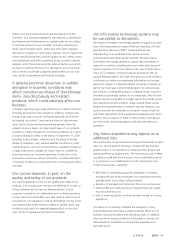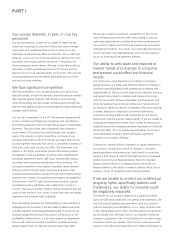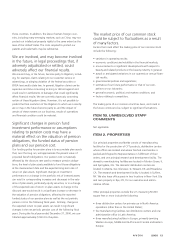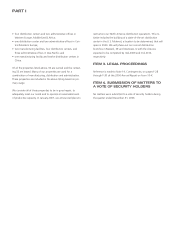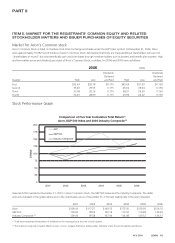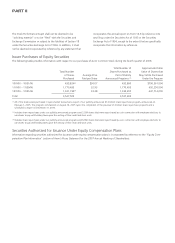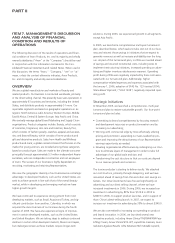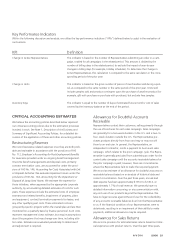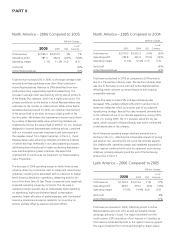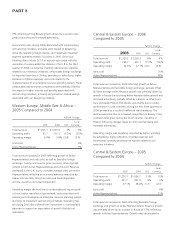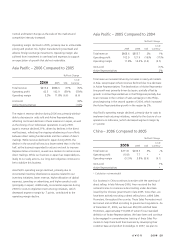Avon 2006 Annual Report Download - page 27
Download and view the complete annual report
Please find page 27 of the 2006 Avon annual report below. You can navigate through the pages in the report by either clicking on the pages listed below, or by using the keyword search tool below to find specific information within the annual report.
Key Performance Indicators
Within the following discussion and analysis, we utilize the key performance indicators (“KPIs”) defined below to assist in the evaluation of
our business.
KPI Definition
Change in Active Representatives This indicator is based on the number of Representatives submitting an order in a cam-
paign, totaled for all campaigns in the related period. This amount is divided by the
number of billing days in the related period, to exclude the impact of year-to-year
changes in billing days (for example, holiday schedules). To determine the Change in
Active Representatives, this calculation is compared to the same calculation in the corre-
sponding period of the prior year.
Change in Units This indicator is based on the gross number of pieces of merchandise sold during a peri-
od, as compared to the same number in the same period of the prior year. Units sold
include samples sold and product contingent upon the purchase of another product (for
example, gift with purchase or purchase with purchase), but exclude free samples.
Inventory Days This indicator is equal to the number of days of estimated future months’ cost of sales
covered by the inventory balance at the end of the period.
CRITICAL ACCOUNTING ESTIMATES
We believe the accounting policies described below represent
our critical accounting policies due to the estimation processes
involved in each. See Note 1, Description of the Business and
Summary of Significant Accounting Policies, for a detailed dis-
cussion of the application of these and other accounting policies.
Restructuring Reserves
We record severance-related expenses once they are both prob-
able and estimable in accordance with the provisions of FAS
No. 112, Employer’s Accounting for Post-Employment Benefits
for severance provided under an ongoing benefit arrangement.
One-time benefit arrangements and disposal costs, primarily
contract termination costs, are accounted for under the provi-
sions of FAS No. 146, Accounting for Costs Associated with Exit
or Disposal Activities. We evaluate impairment issues under the
provisions of FAS No. 144, Accounting for the Impairment or
Disposal of Long-Lived Assets. We estimate the expense for
these initiatives, when approved by the appropriate corporate
authority, by accumulating detailed estimates of costs for such
plans. These expenses include the estimated costs of employee
severance and related benefits, impairment of property, plant
and equipment, contract termination payments for leases, and
any other qualifying exit costs. These estimated costs are
grouped by specific projects within the overall plan and are then
monitored on a quarterly basis by finance personnel. Such costs
represent management’s best estimate, but require assumptions
about the programs that may change over time, including attri-
tion rates. Estimates are evaluated periodically to determine if
and adjustment is required.
Allowances for Doubtful Accounts
Receivable
Representatives contact their customers, selling primarily through
the use of brochures for each sales campaign. Sales campaigns
are generally for a two-week duration in the U.S. and a two- to
four- week duration outside the U.S. The Representative pur-
chases products directly from Avon and may or may not sell
them to an end user. In general, the Representative, an
independent contractor, remits a payment to Avon each sales
campaign, which relates to the prior campaign cycle. The Repre-
sentative is generally precluded from submitting an order for the
current sales campaign until the accounts receivable balance for
the prior campaign is paid; however, there are circumstances
where the Representative fails to make the required payment.
We record an estimate of an allowance for doubtful accounts on
receivable balances based on an analysis of historical data and
current circumstances. Over the past three years, annual bad
debt expense has been approximately $135.0 to $145.0, or
approximately 1.7% of total revenue. We generally have no
detailed information concerning, or any communication with,
any end user of our products beyond the Representative. We
have no legal recourse against the end user for the collectibility
of any accounts receivable balances due from the Representative
to us. If the financial condition of our Representatives were to
deteriorate, resulting in an impairment of their ability to make
payments, additional allowances may be required.
Allowances for Sales Returns
We record a provision for estimated sales returns based on histor-
ical experience with product returns. Over the past three years,
A V O N 2006 21


